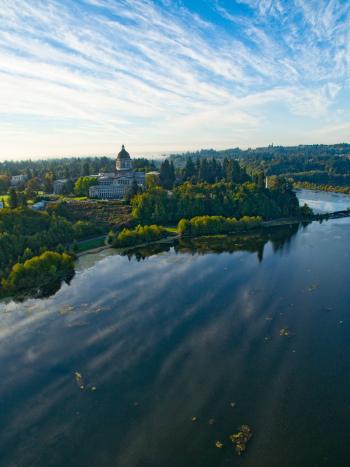DES lowering lake levels for restored estuary design

Editor’s note: We have updated the release to note that the draw down will begin on July 22. The draw down is expected to occur over four days. Refilling the lake will take until Aug. 5. Visitors will get a rare opportunity to see Capitol Lake features and exposed sediment.
OLYMPIA — Visitors to the state’s Capitol Campus will get a rare opportunity to see what lies beneath the water in Capitol Lake next week when the Department of Enterprise Services (DES) temporarily lowers the lake levels to gather data needed for the design of the future restored Deschutes Estuary.
Over the course of four days, beginning July 22, DES will open the water gate on the 5th Avenue Dam to allow water to flow from the lake to Budd Inlet until parts of the lakebed are visible. Crews will take advantage of the low levels to study the underwater features, including the 5th Avenue Dam structure and fish gate, composition of current sediment deposits, and to confirm outfall locations, underground pipes used to disperse stormwater.
Then, DES will close the water gate, allowing the natural river flows to fully refill Capitol Lake. Water will cover the lakebed sediment within a few days, and DES expects it could take until Aug. 5 for the lake to fully refill.
While water levels are low, DES will also fly a small, permitted drone over the lake area to record the conditions and topography of the lakebed.
DES is in the early design stages of restoring the artificial Capitol Lake to its historic estuary setting to improve water quality, wildlife conditions, and community use. It will also improve resilience to sea level rise in Olympia. DES will use this study to move estuary restoration forward to the next stage of design that will refine technical requirements for high-level design concepts.
When the water is lowest between July 24-25, visitors should expect to see the exposed sediments that make up the lakebed. While these conditions are not a good indicator of what the area will look or smell like when DES completes estuary restoration, they are a rare opportunity for visitors to see first-hand how sediment has accumulated behind the 5th Avenue Dam, decreasing lake depth over time.
The pedestrian path around Deschutes Parkway and Capitol Lake will remain open. For safety, visitors should not go out on to the exposed sediment as the lake remains closed. Even though visible water will appear low, water under the surface could make it easy for someone to get stuck.
The public should also stay out of the exposed lakebed to prevent the spread of invasive species. The lake has been closed to public access since 2009, due to the presence of the New Zealand mud snail, an aquatic invasive species. In the future, increased mixing of salt and fresh water in the restored estuary will better control the infestation. In the meantime, crews will have to decontaminate their gear to make sure they don't help the species spread.
In its role as stewards of the Capitol Campus, DES regularly lowers the lake level when needed for maintenance work and to reduce risk of flooding during severe weather. DES is working closely with both the Washington Department of Fish and Wildlife and the Squaxin Island Tribe throughout the estuary restoration design process.
Deschutes Estuary Restoration Project background
After years of study and public input, DES is managing the Deschutes Estuary Restoration Project to restore 260 acres to a native estuary habitat. This is one of the largest estuary restoration projects in an urban area in the country.
Washington state built the 5th Avenue Dam and tide gate in 1951, transforming the Deschutes Estuary into an artificial freshwater reflecting pool for the Capitol Building on the Washington State Capitol Campus. While the lake quickly became a center of community, over time the created ecological impairments and conditions led to water quality violations and sediment build up. The arrival of the New Zealand mud snail finally led to the state closing the lake to recreational water use.
The restored estuary will improve water quality and conditions for native wildlife and allow recreational fishing and some water access to return. DES will also replace the existing 5th Avenue Dam with a new bridge that will have vehicle, bicycle, and pedestrian lanes overlooking the estuary. DES expects design work to continue through at least 2026.
To stay updated on the project and future public involvement opportunities, subscribe to the project newsletter or visit DeschutesEstuaryProject.org.
DES is partnering with FLOYD | SNIDER and KPFF Consulting Engineers of Seattle, Washington for this work.
The Department of Enterprise Services manages the daily care and long-term planning for the State’s 143-acre Capitol Campus, including the buildings, grounds, infrastructure, memorials and art works, and 260-acre Capitol Lake which is being restored to an estuary. The Capitol Campus is the seat of Washington State government and welcomes approximately 400,000 public visitors each year.

